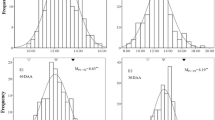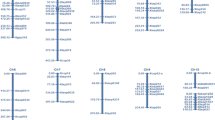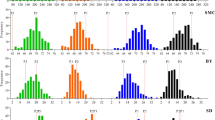Abstract
Increasing sugar content in silage maize stalk improves its forage quality and palatability. The genetic mapping and characterization of quantitative trait loci (QTLs) is considered a valuable tool for trait enhancement, yet little information on QTL for stalk sugar content in maize has been reported. To this end, we investigated QTLs associated with stalk sugar traits including Brix, plant height (PHT), three ear leaves area (TELA), and days to silking (DTS) in two environments using a population of 202 recombinant inbred lines from a cross between YXD053, which has a high stalk sugar content, and Y6-1, which has a low stalk sugar content. A genetic map with 180 SSR and 10 AFLP markers was constructed, which spanned 1,648.6 cM of the maize genome with an average marker distance of 8.68 cM, and QTLs were detected using composite interval mapping. Seven QTLs controlling Brix were mapped on chromosomes 1, 2, 6 and 9 in the combined environments. These QTLs could explain 2.69–13.08 % of the phenotypic variance. One major QTL for Brix on chromosome 2 located between the markers bnlg1909 and umc1635 explained 13.08 % of the phenotypic variance. Y6-1 also contributed QTL allele for increased Brix on chromosome 6. One major QTLs controlling PHT on chromosome 1 and TELA on chromosome 4 were also identified and accounted for 13.68 and 12.49 % of the phenotypic variance, respectively. QTL alleles for increased DTS were located on chromosomes 1 and 5 of YXD053. Significant epistatic effects were identified in four traits, but no significant QTL × environment interactions were observed. The information presented here may be valuable for stalk sugar content improvement via marker-assisted selection in silage maize breeding programs.

Similar content being viewed by others
References
Bai QL (2005) Inheritance of stove quality traits and their determination by near-infrared reflectance spectroscopy (NIRS) in silage maize (Zea may L.). PhD thesis. China Agricultural University, Beijing (in Chinese with English abstract)
Bai QL, Chen SJ, Dai JR (2007) Stalk quality traits and their correlations of maize inbred lines in China. Acta Agron Sin 33:1777–1781 (in Chinese with English abstract)
Bai QL, Shi P, Zhang Y (2009) Stalk quality traits evaluation and their correlation analysis with maize inbred lines in China. J Shanxi Agric Sci 37(4):14–17 (in Chinese with English abstract)
Bian YL, Yazaki SJ, Inoue MK, Cai HW (2006) QTLs for sugar content of stalk in sweet sorghum (Sorghum bicolor L. Moench). Agric Sci China 5:736–744
Bian YL, Du K, Wang YJ, Deng DX (2009) Distribution of sugar content in maize stalk. Acta Agron Sin 35:2252–2257 (in Chinese with English abstract)
Bian YL, Du K, Wang YJ, Deng DX, Cheng JR, Kong YB (2010) Screening and evaluation for high sugar content of stem in maize germplasm. J Plant Genet Resour 11:315–319 (in Chinese with English abstract)
Bian YL, Deng DX, Du K, Gu X, Wang YJ, Yin ZT, Sun DL (2011) Relations of stalk’s sugar content to yield and main agronomic traits in corn. Acta Agric Shanghai 27(4):48–53 (in Chinese with English abstract)
Bian YL, Du K, Gu X, Wang YJ, Yin ZT, Sun DL, Deng DX (2012) Genetic effects on sugar content of stalk in maize. J China Agric Univ 17(1):17–19 (in Chinese with English abstract)
Bian YL, Gu X, Sun DL, Wang YJ, Yin ZT, Wang YQ, Deng DX (2013) Inheritance analysis of stalk sugar content in maize. Acta Agron Sin 39:249–257 (in Chinese with English abstract)
Cai HG, Chu Q, Gu RL, Yuan LX, Liu JC, Zhang XZ, Chen FJ, Mi GH, Zhang FS (2012) Identification of QTLs for PHT, ear height and grain yield in maize (Zea mays L.) in response to nitrogen and phosphorus supply. Plant Breed 131:502–510
Calvino M, Messing J (2012) Sweet sorghum as a model system for bioenergy crops. Curr Opin Biotechnol 23:323–329
Carpita NC, McCann MC (2008) Maize and sorghum: genetic resources for bioenergy grasses. Trends Plant Sci 13:415–420
Coors JG (1996) Findings of the Wisconsin maize silage consortium. In: Proceedings of Cornell Nutrition Conference for Feed Manufacturers, Rochester, New York, Cornell University, Ithaca, New York. pp 20–28
Dalvi US, Chavan UD, Shinde MS, Gadakh SR (2012) Effect of staggered planting on stalk yield, sugar content and ethanol yield of sweet sorghum for increasing harvest window. Sugar Tech 14:144–147
Froetschel MA, Ely LO, Amos HE (1991) Effects of additives and growth environment on preservation and digestibility of wheat silage fed to Holstein heifers. J Dairy Sci 74:546–556
Ganesh Kumar C, Fatima A, Srinivasa Rao P, Reddy BVS, Rathore A, Nageswar Rao R, Khalid S, Ashok Kumar A, Kamal A (2010) Characterization of improved sweet sorghum genotypes for biochemical parameters, sugar yield and its attributes at different phenological stages. Sugar Tech 12:322–328
Guan YA, Wang HL, Qin L, Zhang HW, Yang YB, Gao FJ, Li RY, Wang HG (2011) QTL mapping of bio-energy related traits in Sorghum. Euphytica 182:431–440
Johnson LM, Harrison JH, Davidson D, Mahanna WC, Shinners K (2003) Maize silage management: effects of hybrid, maturity, inoculation, and mechanical processing on fermentation characteristics. J Dairy Sci 86:287–308
Kosambi DD (1943) The estimation of map distances from recombination values. Ann Eugen 12:172–175
Kruse S, Herrmann A, Kornher A, Taube F (2008) Genotypic and environmental variation in water soluble carbohydrate content of silage maize. Field Crops Res 106:191–202
Lander ES, Green P, Abrahamson J, Barlow A, Daly MJ, Lincoln SE, Newburg L (1987) MAPMAKER: an interactive computer package for constructing primary genetic maps of experimental and natural population. Genomics 1:174–181
Li CX (2009) The effects of lactic acid bacteria on the quality and microbial fermentation of whole maize silage. PhD thesis. Chinese Academy of Agricultural Sciences, Beijing (in Chinese with English abstract)
Li FH, Dong HH, Wu JQ, Yang ZS, Lou CJ, Qian F, Guo DS, Hao ZB (2007) Selection of new maize combination with high content sugar material. J Maize Sci 15(3):19–21 (in Chinese with English abstract)
Lin YR, Schertz KF, Paterson AH (1995) Comparative analysis of QTLs affecting PHT and maturity across the Poaceae, in reference to an interspecific sorghum population. Genetics 141:391–411
Liu RH, Meng JL (2003) MapDraw: a Microsoft Excel macro for drawing genetic linkage maps based on given genetic linkage data. Hereditas 25:317–321
Lu YL, Xu J, Yuan ZM, Hao ZF, Xie CX, Li XH, Shah T, Lan H, Zhang SH, Rong TZ, Xu YB (2012) Comparative LD mapping using single SNPs and haplotypes identifies QTL for PHT and biomass as secondary traits of drought tolerance in maize. Mol Breed 30:407–418
McDonald P, Henderson N, Heron SJE (1991) The Biochemistry of Silage, 2nd edn. Chalcombe Publications, Marlow, pp 70–120
Messmer R, Fracheboud Y, Ba¨nziger M, Vargas M, Stamp P, Ribaut JM (2009) Drought stress and tropical maize: QTL-by-environment interactions and stability of QTLs across environments for yield components and secondary traits. Theor Appl Genet 119:913–930
Milligan SB, Gravois KA, Vischoff KP, Martin FA (1990) Crop effects on genetic relationships among sugarcane. Crop Sci 30:927–931
Murray SC, Sharma A, Rooney WL, Klein PE, Mullet JE, Mitchell SE, Kresovich S (2008) Genetic improvement of sorghum as a biofuel feedstock. I. QTL for stem sugar and grain nonstructural carbohydrates. Crop Sci 48:2165–2179
Myburg AA, Remington DL, O’Malley DM, Sederoff RR, Whetten RW (2001) High-throughput AFLP analysis using infrared dye-labeled primers and an automated DNA sequencer. Biotechniques 30:348–357
Parth DK, Jordan DR, Aitken EAB, Mace ES, Jun-ai P, McIntyre CL, Godwin ID (2008) QTL analysis of ergot resistance in sorghum. Theor Appl Genet 117:369–382
Paterson AH, Tanksley SD, Sorrells ME (1991) DNA markers in plant improvement. Adv Agron 46:39–90
Ritter KB, Jordan DR, Chapman SC, Godwin ID, Mace E, McIntyre CL (2008) Identification of QTL for sugar-related traits in a sweet × grain sorghum (Sorghum bicolor L. Moench) recombinant inbred population. Mol Breed 22:367–384
Seale DR, Henderson AR, Pettersson KO, Lowe JF (1986) The effect of addition of sugar and inoculation with two commercial inoculants on the fermentation of lucerne silage in laboratory silos. Grass Forage Sci 41:61–70
Shiringani AL, Frisch M, Friedt W (2010) Genetic mapping of QTLs for sugar-related traits in a RIL population of Sorghum bicolor L. Moench. Theor Appl Genet 121:323–336
Teng F, Zhai LH, Liu RX, Bai W, Wang LQ, Huo DG, Tao YS, Zheng YL, Zhang ZX (2013) ZmGA3ox2, a candidate gene for a major QTL, qPH3.1, for PHT in maize. Plant J 73:405–416
Ungerer MC, Halldorsdottir SS, Modliszekwski JL, Mackay TFC, Purugganan MD (2002) Quantitative trait loci for inflorescence development in Arabidopsis thaliana. Genetics 160:1133–1152
Van Reen R, Singleton WR (1952) Sucrose content in the stalks of maize inbreds. Agron J 44:610–614
Vos P, Hogers R, Bleekers M, Reijans M, van der Lee T, Homes M, Frijters A, Pot J, Peleman J, Kuiper M, Zabeau M (1995) AFLP a new technique for DNA fingerprinting. Nucleic Acids Res 23:4407–4414
Wang Y, Yao J, Zhang ZF, Zheng YL (2006) Comparative analysis of QTL integrated mapping and statistical analysis of QTLs affecting PHT in maize. Chin Sci Bull 51:1776–1786
Wang SC, Basten CJ, Zeng ZB (2007) Windows QTL Cartographer 2.5. Department of Statistics, North Carolina State University, Raleigh, NC. http://statgen.ncsu.edu/qtlcart/WQTLCart.htm
Welton FA, Morris VH, Hartzler AJ (1930) Distribution of moisture, dry matter, and sugars in the maturing maize stem. Plant Physiol 5:555–564
Widstrom NW, Bagby MO, Palmer DM, Black LT, Carr ME (1984) Relative stalk sugar yields among maize populations, cultivars, and hybrids. Crop Sci 24:913–915
Widstrom NW, Carr ME, Bagby MO, Black LT (1988) Distribution of sugar and soluble solids in the maize stalk. Crop Sci 28:861–863
Wilkinson JM, Chapman MPF, Wilkins RJ (1983) Interrelation-ships between pattern of fermentation during ensilage and initial crop composition. In: Proceeding of the14th International Grassland. Lexington, US. pp 631–634
Yan J, Tang H, Huang YQ, Shi YG, Zheng YL, Li JS (2003) Genomic analysis of plant height in maize through molecular marker. Agric Sci China 2:1069–1075
Yang J, Hu CC, Ye XZ, Zhu J (2005) QTLNetwork-2.0. Institute bioinformatics, Zhejiang University, Hangzhou, China. http://ibi.zju.edu.cn/software/qtlnetwork/
Zhang SH, Xi ZY (2007) A new method on rapid extraction of DNA of maize leaf. J Anhui Agric Sci 35(3776):3801 (in Chinese with English abstract)
Zhang DY, Li ZQ, Liu CL (2007) Progress in the study of infection factors on silage quality. J Domest Anim Ecol 28(1):109–112 (in Chinese with English abstract)
Acknowledgments
This study was supported by the National Natural Science Foundation of China (31071426) and was funded by the Priority Academic Program Development of Jiangsu Higher Education Institutions.
Author information
Authors and Affiliations
Corresponding author
Electronic supplementary material
Below is the link to the electronic supplementary material.
Rights and permissions
About this article
Cite this article
Bian, Y., Sun, D., Gu, X. et al. Identification of QTL for stalk sugar-related traits in a population of recombinant inbred lines of maize. Euphytica 198, 79–89 (2014). https://doi.org/10.1007/s10681-014-1085-5
Received:
Accepted:
Published:
Issue Date:
DOI: https://doi.org/10.1007/s10681-014-1085-5




